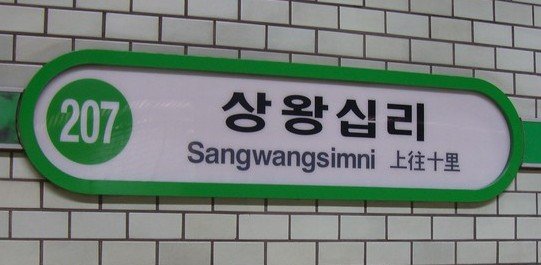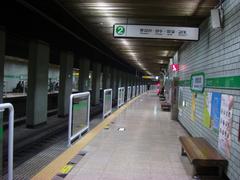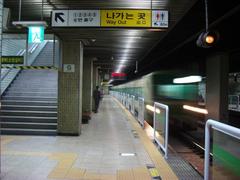
Sangwangsimni Station Visiting Guide – Seoul, South Korea: Tickets, Hours, and Tips
Date: 15/06/2025
Introduction
Sangwangsimni Station (상왕십리역) is a pivotal transit hub in Seoul’s Seongdong-gu district, exemplifying the dynamic blend of the city’s industrial heritage and modern urban vibrancy. Since opening in 1983 as part of Seoul Subway Line 2, the station has anchored a neighborhood shaped by rapid post-war urbanization, industrial growth, and more recent waves of redevelopment (Wikipedia - Sangwangsimni). Beyond efficient infrastructure and accessibility amenities, Sangwangsimni Station is surrounded by a rich tapestry of traditional markets, historic neighborhoods, and notable attractions such as Muhak Peak Neighborhood Park and the Korean Baduk Association (Seoul Sub→urban). Travelers benefit from operating hours that stretch from early morning to midnight, flexible ticketing including T-money cards, and seamless connections to Seoul’s wider transportation network (Seoul Metro Official Site). This guide equips you with all you need to know—operating hours, ticketing, accessibility, nearby attractions, and practical tips—for a rewarding visit to Sangwangsimni Station and its lively environs (Academia.edu - Gentrification in Seoul).
Table of Contents
- Introduction
- Historical Background and Urban Development
- Visiting Sangwangsimni Station: Hours, Tickets, and Facilities
- Accessibility and Station Amenities
- Urban Renewal and Community Transformation
- Cultural and Historical Landmarks Nearby
- Safety, Events, and Notable Incidents
- Practical Travel Tips
- Frequently Asked Questions (FAQ)
- Summary and Final Tips
- References
Historical Background and Urban Development
From Industrial Hub to Modern Transit Center
Sangwangsimni Station is located in an area historically characterized by working-class neighborhoods and a mixed-use urban fabric. The district’s growth after the Korean War mirrored Seoul’s broader transformation, with an influx of residents and the rise of small-scale manufacturing, machine shops, and traditional markets (History of South Korea). The station’s opening in 1983 on Line 2 was part of Seoul’s efforts to decentralize growth and connect emerging districts to the city center (Wikipedia - Sangwangsimni).
The station, built underground beneath Wangsimni-ro with seven main exits, was equipped with escalators, elevators, ticket vending machines, and safety features such as platform screen doors added later (Seoul Sub→urban).
Visiting Sangwangsimni Station: Hours, Tickets, and Facilities
Operating Hours
- First train: Around 5:30 AM
- Last train: Just before midnight (exact times may vary slightly by exit and service day)
- Train Frequency: Every 3–5 minutes during peak hours; every 5–8 minutes off-peak (Seoul Metro Official Site)
Ticketing Options
- Single-ride tickets: 1,250–1,650 KRW, depending on distance
- T-money Card: Rechargeable, accepted on all public transit, available at kiosks and convenience stores
- Discover Seoul Pass: 24, 48, 72-hour options for unlimited rides and attraction discounts (Visit Seoul)
Unused balances on cards can be refunded at station machines.
Station Amenities
- Clean, accessible restrooms on all levels
- Elevators, escalators, and tactile paving for accessibility
- Coin lockers and luggage storage
- Free Wi-Fi throughout the station
- Retail outlets: Olive Young, convenience stores, bakeries, cafes (Visit Korea)
- Information desks with multilingual staff
- CCTV monitoring and emergency call points
Accessibility and Station Amenities
Sangwangsimni Station is fully accessible, featuring:
- Elevators and ramps at all entrances/exits
- Tactile paving for the visually impaired
- Accessible ticket gates and restrooms
- Bilingual signage (Korean/English)
- Real-time digital train arrival displays
These features make the station convenient for travelers with disabilities, families, and those carrying luggage.
Urban Renewal and Community Transformation
The area around Sangwangsimni has undergone significant redevelopment, particularly under Seoul’s Joint Redevelopment Programme. Many older structures have been replaced by high-rise apartments and commercial buildings, altering the district’s former industrial character (Academia.edu - Gentrification in Seoul). While this has brought modern amenities and revitalization, it has also led to both direct and indirect displacement of long-term residents and small businesses. Efforts are now focused on balancing modernization with social inclusion and community preservation.
Cultural and Historical Landmarks Nearby
- Muhak Peak Neighborhood Park (무학봉 근린공원): Offers panoramic views of northern Seoul—ideal for photography and a peaceful escape.
- Korean Baduk Association (한국기원): Center for Korea’s traditional board game, Baduk (Go).
- Wangsimni Area: Historic district tied to the 14th-century legend of Buddhist monk Muhak and the founding of Gyeongbokgung Palace (Wikipedia - Wangsimni Station).
- Hanyang University: Renowned institution with a vibrant campus, one stop away.
- Cheonggyecheon Stream: Urban renewal project with scenic paths and cultural events (Korea Travel Planning).
- Seoullo 7017: Elevated urban park blending greenery and public art.
Many traditional markets, artisan workshops, and local eateries are within walking distance, providing a window into Seoul’s evolving cultural tapestry.
Safety, Events, and Notable Incidents
- 2014 Subway Collision: On May 2, 2014, a collision at Sangwangsimni Station injured 238 people, prompting major safety upgrades across the system (Wikiwand - Sangwangsimni Station).
- The station is equipped with extensive CCTV, emergency response equipment, and regular safety drills.
Occasionally, cultural exhibitions and local events take place within the station—check Seoul Metro’s website for updates.
Practical Travel Tips
- Avoid peak hours (7–9 AM, 6–8 PM) for a more relaxed journey.
- Use T-money or Discover Seoul Pass for convenience and savings.
- Download transit apps (Seoul Metro, Naver Maps, Kakao Maps) for real-time navigation.
- Utilize luggage lockers for hands-free exploration.
- Leverage free Wi-Fi and information desks for assistance.
- Follow local subway etiquette (stand on the right, give up seats for priority passengers).
Frequently Asked Questions (FAQ)
Q: What are the station’s operating hours?
A: Approximately 5:30 AM to midnight daily.
Q: How do I buy tickets?
A: Use vending machines for single-journey tickets or purchase/recharge a T-money card at kiosks or convenience stores.
Q: Is the station accessible for travelers with disabilities?
A: Yes—elevators, ramps, tactile paving, and accessible restrooms are provided.
Q: What attractions are nearby?
A: Muhak Peak Park, Korean Baduk Association, Wangsimni’s historic sites, Cheonggyecheon Stream, and more.
Q: Are guided tours available?
A: Local operators offer guided walks exploring Seongdong-gu’s history and culture.
Q: Is free Wi-Fi available?
A: Yes, Wi-Fi is provided throughout the station.
Summary and Final Tips
Sangwangsimni Station stands as a gateway to both Seoul’s past and its dynamic present. With comprehensive amenities, integrated transportation, and proximity to unique cultural and historical sites, the station is ideal for both commuters and explorers. While redevelopment brings change, the area retains much of its local character and offers authentic experiences. For a smooth visit, plan ahead using transit apps, choose off-peak hours, and consider using travel cards like T-money or Discover Seoul Pass.
Enhance your journey by downloading the Audiala app for tailored travel planning, and explore related articles for deeper insights into Seoul’s subway and urban attractions.
References
- Seoul Sub→urban – Sangwangsimni Station: History, Visiting Tips, and Nearby Attractions in Seoul, 2023
- Wikipedia - Sangwangsimni (French)
- Academia.edu - Changing Scope of Gentrification in Seoul: Neighborhood Transformation and Displacement in Sangwangsimni and Changsin Sungin Industrial Clusters, 2021
- Wikiwand - Sangwangsimni Station Collision Incident, 2014
- Seoul Metro Official Site, 2025
- Visit Korea - Olive Young Sangwangsimni Station Branch, 2025
- Seoul Metropolitan Government - Urban Planning and Metro Map Redesign, 2024
- MetroLineMap – Sangwangsimni Station
- Baidu Baike – Sangwangsimni Station
- Travel Stained – Korea in June: Weather & Things to Do
- Korea Travel Planning – Things to Do in Seoul














































































































































































































